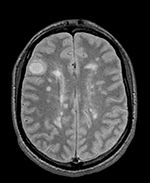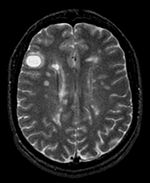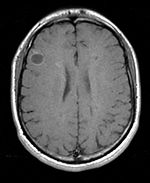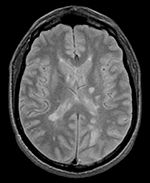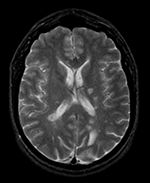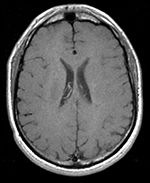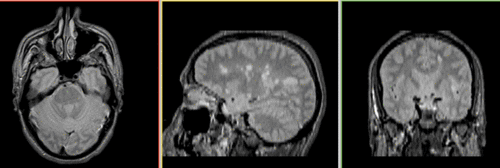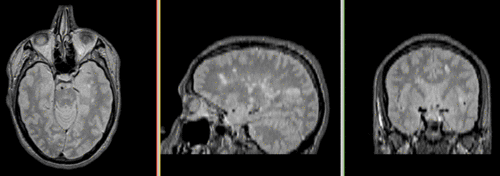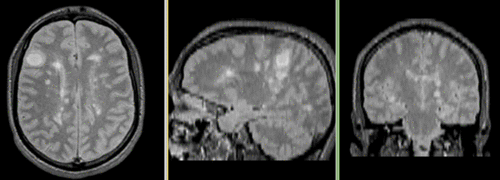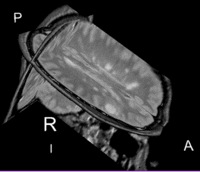Projects:RegistrationLibrary:RegLib C04
Back to ARRA main page
Back to Registration main page
Back to Registration Use-case Inventory
Contents
Slicer Registration Library Case 04: Intra-subject Brain MR of Multiple Sclerosis: Multi-contrast series for lesion change assessment
Objective / Background
This scenario occurs in many forms whenever we wish to assess change in a series of multi-contrast MRI. The follow-up scan(s) are to be aligned with the baseline, but also the different series within each exam need to be co-registered, since the subject may have moved between acquisitions. Hence we have a set of nested registrations. This particular exam features a dual echo scan (PD/T2), where the two structural scans are aligned by default. The post-contrast T1-GdDTPA scan however is not necessarily aligned with the dual echo. Also the post-contrast scan is taken with a clipped field of view (FOV) and a lower axial resolution, with 4mm slices and a 1mm gap (which we treat here as a de facto 5mm slice).
Keywords
MRI, brain, head, intra-subject, multiple sclerosis, MS, multi-contrast, change assessment, dual echo, nested registration
Input Data
 reference/fixed : PD baseline exam , 0.9375 x 0.9375 x 3 mm voxel size, axial acquisition, RAS orientation.
reference/fixed : PD baseline exam , 0.9375 x 0.9375 x 3 mm voxel size, axial acquisition, RAS orientation. reference/fixed : T2 baseline exam , 0.9375 x 0.9375 x 3 mm voxel size, axial acquisition, RAS orientation.
reference/fixed : T2 baseline exam , 0.9375 x 0.9375 x 3 mm voxel size, axial acquisition, RAS orientation. moving: T1-GdDTPA baseline exam 0.9375 x 0.9375 x 5 mm voxel size, axial acquisition.
moving: T1-GdDTPA baseline exam 0.9375 x 0.9375 x 5 mm voxel size, axial acquisition. moving: PD follow-up exam 0.9375 x 0.9375 x 3 mm voxel size, axial acquisition.
moving: PD follow-up exam 0.9375 x 0.9375 x 3 mm voxel size, axial acquisition. tag: T2 follow-up exam 0.9375 x 0.9375 x 3 mm voxel size, axial acquisition.
tag: T2 follow-up exam 0.9375 x 0.9375 x 3 mm voxel size, axial acquisition. moving:T1-GdDTPA follow-up exam0.9375 x 0.9375 x 5 mm voxel size, axial acquisition.
moving:T1-GdDTPA follow-up exam0.9375 x 0.9375 x 5 mm voxel size, axial acquisition.
Registration Challenges
- we have multiple nested transforms: each exam is co-registered within itself, and then the exams are aligned to eachother
- potential pathology change can affect the registration
- anisotropic voxel size causes difficulty in rotational alignment
- clipped FOV and low tissue contrast of the post-contrast scan
Key Strategies
- we first register the post-contrast scans within each exam to the PD
- we also move the T2 exam within the same Xform
- second we register the follow-up PD scan to the baseline PD
- we then nest the first alignment within the second
- we compare T1Gd to T1Gd, which went through 2 transforms. We correct residual misalignment with a 3rd correction transform
- because of the contrast differences and anisotropic resolution we use Mutual Information as cost function for better robustness
- we adjust the expected translation and rotational parameter settings to the visual assessment of the input data (i.e. initial misalignment)
Registration Results
Download
- Registration Library Case 04: MS Multi-contrast series (PD,T2, T1-GdDTPA): Lesion change assessment (Data,Presets, Solution, zip file 17 MB)
- download/view guided video tutorial
- download power point tutorial
Link to User Guide: How to Load/Save Registration Parameter Presets
